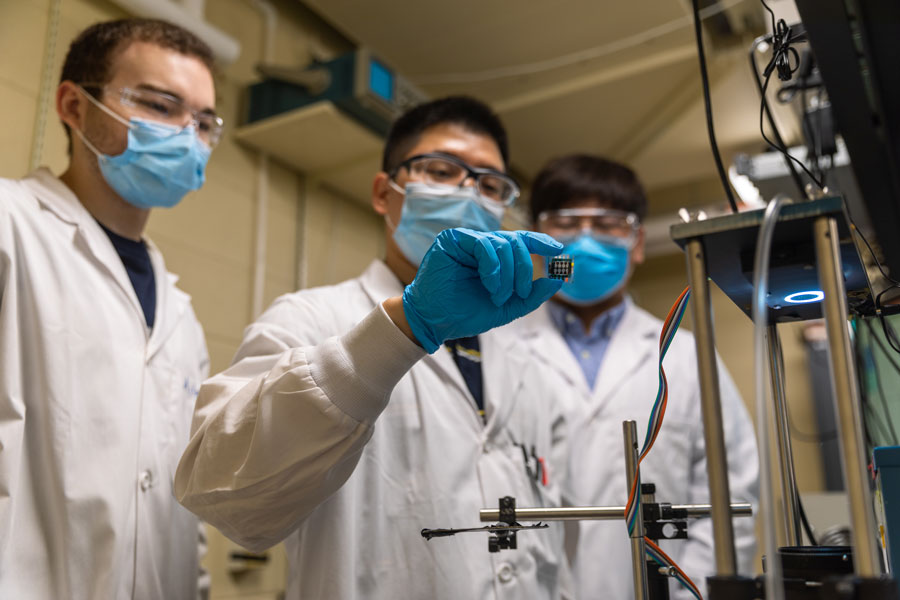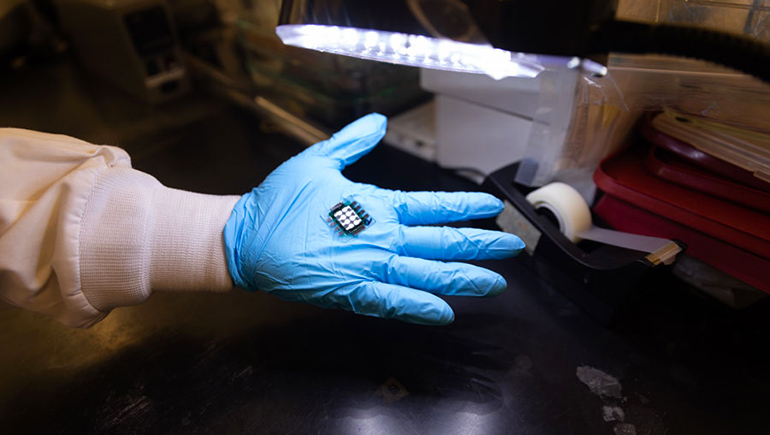
( University of Toronto Engineering students demonstrate their prototype all-perovskite tandem solar cell. Photo by Aaron Demeter/University of Toronto )
In the race to make solar energy more practical amidst soaring gas prices and threats of climate catastrophe, a team of researchers is taking steps toward a more efficient, higher-voltage solar cell.
Now, a Northwestern University, University of Toronto and the University of Toledo team is introducing in a new type of solar cell produced without silicon. Not only does the new cell have extremely high efficiency and record-setting voltage, it also bypasses the need for silicon, which is energetically costly to produce and purify.
In a new paper published this week in Nature, the international team of researchers used two different layers of perovskites — a type of nanocrystal dispersed in a liquid and coated onto a surface using low-cost, well-established techniques. The researchers then tuned each perovskite layer to a different part of the solar spectrum, producing a tandem solar cell.
The team’s prototype solar cell measures one square centimeter in area and produces an open-circuit voltage of 2.19 electron volts, a record for all-perovskite tandem solar cells. Its power-conversion efficiency reached 27.4%, which also breaks the current record for traditional silicon solar cells.
“Further improvements in the efficiency of solar cells are crucial for the ongoing decarbonization of our economy,” said corresponding author Ted Sargent. “While silicon solar cells have undergone impressive advances in recent years, there are inherent limitations to their efficiency and cost, arising from material properties. Perovskite technology can overcome these limitations, but, until now, it had performed below its full potential. Our latest study identifies a key reason for this and points a way forward.”
Sargent joined Northwestern this fall as the Lynn Hopton Davis and Greg Davis Professor of Chemistry at the Weinberg College of Arts and Sciences and a professor of electrical and computer engineering in the McCormick School of Engineering.
By adjusting the thickness and chemical composition of the perovskite crystal films, manufacturers can selectively “tune” which wavelengths of light are absorbed and converted into electricity. This is a beneficial contrast to silicon, which always absorbs the same limited section of the solar spectrum.
“In our cell, the top perovskite layer absorbs well in the ultraviolet part of the spectrum, as well as some visible light,” said Chongwen Li, a postdoctoral researcher in Sargent’s lab and one of five co-first authors of the new paper. “The bottom layer has a narrow band gap, which is tuned more toward the infrared part of the spectrum. Between the two, we cover more of the spectrum than would be possible with silicon.”

(This prototype all-perovskite tandem solar cell measures one square centimeter. It has a 24.7% power conversion efficiency, which is higher than is currently possible with traditional single-junction silicon solar cells. Photo by Aaron Demeter/University of Toronto)
The tandem design enables the cell to produce a very high open-circuit voltage, which in turn improves its efficiency. But the key innovation came when the team analyzed the touchpoints between the perovskite layer, where light is absorbed and transformed into excited electrons, and the adjacent layer, known as the electron transport layer.
“What we found is that the electric field across the surface of the perovskite layer — we call it the surface potential — was not uniform,” co-lead author and Ph.D. student Aidan Maxwell said. “The effect of this was that in some places, excited electrons were moving easily into the electron transport layer, but, in others, electrons were being lost to the circuit.”
To address this challenge, the team coated the surface of the perovskite layer with a substance known as 1,3-propanediammonium (PDA).
“PDA has a positive charge, and it is able to even out the surface potential,” postdoctoral fellow Hao Chen said. “When we added the coating, we got much better energetic alignment of the perovskite layer with the electron transport layer, and that led to a big improvement in our overall efficiency.”
The cell was independently certified at the National Renewable Energy Laboratory in Colorado, delivering an efficiency of 26.3%. The team used industry standard methods to measure the stability of the new cell and found that it maintained 86% of its initial efficiency after 500 hours of continuous operation.
"Continuing to advance the efficiency and stability of next-generation solar cells is a crucial priority for decarbonizing the electricity supply,” said Professor Alberto Salleo, chair of the department of materials science and engineering at Stanford University, who was not involved in the study. “The team developed a deep chemical understanding of what was limiting a crucial interface in perovskite solar cells. These insights from basic science, acted on with innovative materials engineering strategies, will continue to drive the field forward.”
Next, the team hopes to scale their production for commercial use, further enhance the tandem cell’s efficiency and improve its stability.
“In this work, we’ve focused on the interface between the perovskite layer and the electron transport layer, but there is another important layer that extracts the ‘holes’ those electrons leave behind,” Sargent said. “One of the intriguing things in my experience with this field is that learning to master one interface doesn't necessarily teach you the rules for mastering the other interfaces. I think there's lots more discovery to be done.”
Maxwell said that the ability of perovskite technology to hold its own against silicon, even though the latter has had a multi-decade head start, is encouraging. The industry’s ability to incorporate new materials and diversify the products it offers will accelerate the economy toward decarbonization.
“In the last 10 years, perovskite technology has come almost as far as silicon has in the last 40,” Maxwell said. “Just imagine what it will be able to do in another 10 years.”
Original source can be found here.




 Alerts Sign-up
Alerts Sign-up